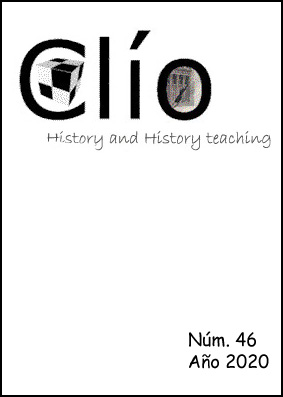“Samudaripen: from the persecution to the genocide of the Roma people”.A teaching proposal for the university context
Una propuesta docente para el ámbito universitario
DOI:
https://doi.org/10.26754/ojs_clio/clio.2020465276Keywords:
Samudaripen, Romani Holocaust, Romani History, Higher Education, University teaching.Abstract
The history of the Roma people is one of the most neglected subjects in pre-university and university education. Even more so is the Samudaripen, the Romani Holocaust, an episode barely mentioned in history classes both in secondary education and in the Bachelor and Master's degrees in the branches of Humanities and Social Sciences. The first part of this article offers a review of the literature in which the main reflections made on this curricular gap are presented and the need to incorporate the teaching of Samudaripen into contemporary history classes at university level is argued. The second part describes a sequence of activities entitled "Samudaripen: from the persecution to the genocide of the Roma people", designed as part of a "cycle of teaching improvement" (FIDOP, University of Seville) in the 1st year Contemporary History course.
Downloads
References
About, I. (2012). Underclass Gypsies: An Historical Approach on Categorisation and Exclusion in France in the Nineteenth and Twentieth Centuries. En M. Stewart (Ed.), The Gypsy Menace. Populism and the New Anti-Gypsy Politics (pp. 95-114). Hurst.
De Alba, N., y Porlán, R. (2017). La metodología de enseñanza. En R. Porlán (Ed.), Enseñanza Universitaria. Cómo mejorarla (pp. 37-53). Morata.
Fraser, A. (1992). The Gypsies. Blackwell.
García Pérez, F. F., y Porlán, R. (2017). Los principios didácticos y el Modelo Didáctico Personal. En R. Porlán (Ed.), Enseñanza Universitaria. Cómo mejorarla (pp. 94-104). Morata.
Goldstein, Y. (2001). Dilemas educativos en la enseñanza de la Shoá. Nuestra Memoria, 18, 36-38. https://www.yadvashem.org/es/education/educational-materials/proposals/ dilemmas-in-teaching-about-the-holocuast.html
González Delgado, M. (2016). Las dificultades de enseñar el pasado en las aulas: La representación del Holocausto en los libros de texto de Historia en España. En S. González Gómez, I. Pérez Miranda y A. M. Gómez Sánchez (coords.). Mors certa, hora incerta. Tradiciones, representaciones y educación ante la muerte (pp. 127-154). FahrenHouse.
Hancock, I. (1997). Genocide of the Roma in the Holocaust. En I. Charny (Ed.), Encyclopedia of genocide (pp. 501-508). ABC-CLIO.
Hancock, I. (1999). Romani Victims of the Holocaust and Swiss Complicity. En R. L. Brooks (Ed.), When Sorry Isn’t Enough: The Controversy Over Apologies and Reparations for Human Injustice, (pp. 68-76). NYC Press.
Hancock, I. (2001). Downplaying the Porrajmos: The Trend to Minimize the Romani Holocaust. Journal of Genocide Research, 3(1), 78-85. https://doi.org/10.1080/14623520120037743
Hancock, I. (2007). On the Interpretation of a Word: “Porrajmos” as Holocaust. En M. Hayes y T. Acton (Eds.), Travellers, Gypsies, Roma: The Demonisation of Difference (pp. 53-57). Cambridge Scholars Publishing.
Heuss, H., Sparing, F., Fing, K. y Kenrick, D. (Eds.) (2006). The Gypsies during the Second World War. University of Herthfordshire Press.
Jiménez González, N. (2016). La historia del pueblo gitano: memoria e inclusión en el currículo educativo. Memoria histórica y democrática, 2, 113-123. https://revistes.gva.es/ ojs/index.php/drets/article/view/99
Liégeois, J. P. (2012). The Council of Europe and Roma: 40 years of action. Council of Europe.
Lucassen, L. (1997). “Harmful tramps”. Police professionalization and gypsies in Germany, 1700-1945. Crime, History & Societies, 1(1), 27-50. https://doi.org/10.4000/chs.1029
Luna Serrano, E., y Torquemada, A. D. (2008). Los cuestionarios de evaluación de la docencia por los alumnos: balance y perspectivas de su agenda. Revista electrónica de investigación educativa, 10 (SPE), 1-15. http://redie.uabc.mx/NumEsp1/contenido-lunatorquemada.html
Martínez Martínez, M. (2014). Los gitanos y las gitanas de España a mediados del siglo XVIII. El fracaso de un proyecto de “exterminio”. Círculo rojo.
Pérez, I. L., González, L. G. y Maldonado, A. L. (2017). Brainstorming como recurso docente para desarrollar competencia investigadora. Revista Iberoamericana de Educación, 74(1), 133-148. https://doi.org/10.35362/rie741631
Polak, K. (2013). Teaching about the genocide of the Roma and Sinti during the Holocaust: chances and challenges in Europe today. Intercultural Education, 24(1-2), 7-992. https://doi.org/10.1080/14675986.2013.782688
Santos, T., Macías, F., Amador, J. y Corte?s, D. (2016). Samudaripen, el Genocidio Gitano: ¿Volveremos a Repetir la Historia?. Scientific Journal on Intercultural Studies, 2(1), 2-29. http://dx.doi.org/10.17583/recei.2016.1897
Sierra, M. (2018). Historia gitana. Enfrentarse a la maldición de George Borrow. Ayer, 109, 351-365. http://revistaayer.com/articulo/145
Sierra, M. (2020). Holocausto gitano. El genocidio romaní bajo el nazismo. Arzalia Ediciones.
Solkoff, N., y Allen, W. S. (1978). Teaching the Holocaust at the University Level. Teaching of Psychology, 5(4), 189-191. https://doi.org/10.1207/s15328023top0504_4
Suárez Álvarez, M. A. (s/f). La enseñanza del Holocausto en Bachillerato: Reflexiones y Propuestas. Yad Vashem. Centro mundial de conmemoración de la Shoá. https://www.yadvashem.org/es/education/educational-materials/proposals/reflections.html
Totten, S. (2001). Addressing the “null curriculum”: Teaching about Genocides Other than the Holocaust. Social Education, 65(5), 309-313. http://www.socialstudies.org/sites/default/ files/publications/se/6505/650509.html
Totten, S., Bartrop, P. R. y Jacobs, S. L. (Eds.) (2004). Teaching about the Holocaust: Essays by College and University Teachers. Praeger.
Downloads
Published
How to Cite
Issue
Section
License
Copyright (c) 2020 Begoña Barrera López

This work is licensed under a Creative Commons Attribution-NonCommercial-ShareAlike 4.0 International License.
This work is licensed under a Creative Commons Attribution-NonCommercial-ShareAlike 4.0 International License.
Copyright remains the property of authors. Permission to reprint must be obtained from the authors and the contents of JoS cannot be copied for commercial purposes. JoS does, however, reserve the right to future reproduction of articles in hard copy, portable document format (.pdf), or HTML editions of JoS.






